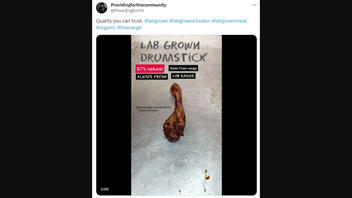
Does a video shared on X document lab-grown meat moving autonomously? No, that's not true: The video in question was made by a content creator who produces videos containing sculptures of food items that move as if they are alive. Lab-grown meat is not created in a way that would allow it to move autonomously. Sarcastic captions on the video include phrases such as "Semi Free-range" and "67% natural."
The claim originated in a video shared to X on November 25, 2023, (archived here) that appeared to show "lab-grown meat" as it moved autonomously. A caption that accompanied the post read:
Quality you can trust. #labgrown #labgrownchicken #labgrownmeat #organic #freerange
Below is how the post appeared at the time of this publication:
(Source: X screenshot taken Sun Nov 26 17:58:00 UTC)
The video above included a text overlay that credited the clip to "@providingforthecommunity" and "Russel Cameron," a content creator who produces videos of food products that move as if they are alive and are often featured in a laboratory-like setting.
Lead Stories looked through the poster's Instagram, TikTok, and YouTube accounts and found the account's other self-described "creepy" food content, including a "newborn hairy lab banana" and juice-producing lab fruits. The social media profiles also contained a link to the creator's webpage, which sold similar items including a "Down and out Santa" and several "monsters." Lead Stories contacted Cameron and will update the article, as appropriate, should we receive a response.
Lab-grown meat is not created in a way that would enable it to move and pulsate as is seen in the video.
The food science nonprofit organization European Food Information Council described lab-grown meat as meat that is developed from animal cell culture and not from the traditional raising or slaughter of animals. This process does not produce entire anatomical structures like a drumstick, for example, that would need tendons, bones, nerve endings, and other physiology that facilitate such movements.
The U.S. Food and Drug Administration (FDA) described this process (archived here) in more detail:
Step 1: Manufacturers typically start with a sample of cells from the tissue of an animal, a process that does not require harm to or death of the animal. Some cells from the sample are selected, screened, and grown to make a "bank" of cells to store for later use.
Step 2: A small number of cells are taken from the cell bank and placed in a tightly controlled and monitored environment (typically, a number of sealed sterile vessels of increasing size) that supports growth and cellular multiplication by supplying appropriate nutrients and other factors.
Step 3: After the cells have multiplied many times over into billions or trillions of cells, additional substances (for example, protein growth factors, new surfaces for cell attachment, additional nutrients) are added to the controlled environment to enable the cells to differentiate into various cell types and assume characteristics of muscle, fat, or connective tissue cells.
Step 4: Once the cells have differentiated into the desired type, the cellular material can be harvested from the controlled environment and prepared using conventional food processing and packaging methods.
At the time of this publication, at least two companies in the U.S. were given pre-market approval by the FDA and the Department of Agriculture's Food Safety and Inspection Service (USDA-FSIS) clearing the way to sell their products in the U.S. As Lead Stories reported in August 2023, the USDA-FSIS approval was granted to Upside Foods and Good Meat in June 2023.
Lead Stories has also reported that swollen plastic packaging does not indicate that chicken meat is unsafe for human consumption, that a report assessing the safety of a plant-based meat product does not prove that meat grown in a laboratory causes cancer in humans, and that a ballot initiative proposed in Oregon would not ban all animal meat and replace it with "synthetic meat."
Other Lead Stories fact checks related to lab-grown meat can be read here.

















